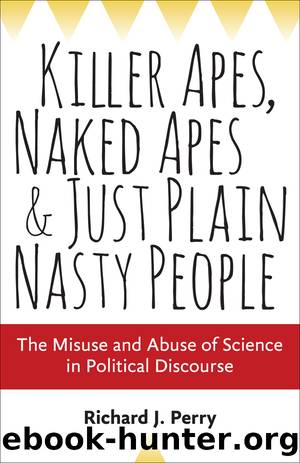Killer Apes, Naked Apes, and Just Plain Nasty People by Richard J. Perry

Author:Richard J. Perry
Language: eng
Format: epub
Publisher: Johns Hopkins University Press
THE GENERIC âPRIMITIVEâ
There are a few problems with this. Almost without exception, hunting peoples in historic times have lived in areas unsuitable for agriculture or animal husbandryâtoo dry, too cold, or whatever. In some cases, theyâve ended up in such areas as refugees, pushed into them by expanding agricultural or herding peoples who, if not necessarily more aggressive, were certainly more numerous because of their food supply. Humans who lived before agriculture, though, had the entire habitable world at their disposal. Why would they have chosen to live in deserts when they had access to much more congenial, richer environments? Still, at least some of the strategies that have worked for historic hunting and gathering people might also have worked for ancient people making a living the same way.
To an extent, perhaps. But to look at a few well-documented cases of hunting peoples in more recent timesâthe San of southern Africa, for example, the Inuit of the central Canadian Arctic Coast, Australian peoples of the Western Desert, or Dene of the western Canadian subarcticâone thing that strikes us is their cultural diversity. True, they do have some things in common: Theyâve had low population densities, and theyâve needed to be mobile in order to subsist on thinly scattered and often changing food sources in an environment of meager resources. This has placed constraints on what options were feasible for them.
But remember, hunters of the Pleistocene were not restricted to environments that nobody else wanted. Perhaps the best historic examples we have of nonagricultural peoples inhabiting a rich environment are on the North Pacific Coast of North America. There, such groups as the Haida, Tlingit, and Kwakwala speakers had relatively dense populations with large communal cedar plank buildings, elaborate systems of social ranking, distinctive graphic art, and complex ceremonial systems. All of this, and more, was possible because of their rich food supply of fish, especially salmon, and sea mammals.
The bottom line is that historic hunting peoples donât tell us much that we would like to know about life in the Pleistocene. These are not our living ancestors. Theyâre not people locked into some sort of time warp, as some writers seem to have imagined. Their histories are every bit as long and as deep as anyone elseâs. And beyond some general similarities in organization, their cultures have been quite diverse. But that hasnât stopped sociobiologists from using these sources as rich fertilizer for the imagination.14
Thereâs a certain irony to this. On the one hand, thereâs been a tendency to visualize a generic âprimitiveâ way of life that blurs the distinction between historic nonindustrial societies and our prehistoric ancestors. On the other hand, as weâll discuss below, thereâs been little attempt in the course of this enterprise to pay much detailed attention to other living cultures when discussing an allegedly universal âhuman nature.â
Facile references to our generic hunterâgatherer ancestors persist. In February 2013, the anthropologist Helen Fisher appeared on a television show called The Cycle on MSNBC. Fisher is somewhat unusual among anthropologists in embracing a sociobiological perspective.
Download
This site does not store any files on its server. We only index and link to content provided by other sites. Please contact the content providers to delete copyright contents if any and email us, we'll remove relevant links or contents immediately.
| Anthropology | Archaeology |
| Philosophy | Politics & Government |
| Social Sciences | Sociology |
| Women's Studies |
Born to Run: by Christopher McDougall(7065)
The Leavers by Lisa Ko(6912)
iGen by Jean M. Twenge(5367)
Sapiens by Yuval Noah Harari(5294)
The Kite Runner by Khaled Hosseini(5085)
Spare by Prince Harry The Duke of Sussex(5076)
Machine Learning at Scale with H2O by Gregory Keys | David Whiting(4192)
Bullshit Jobs by David Graeber(4101)
Never by Ken Follett(3799)
Goodbye Paradise(3729)
Livewired by David Eagleman(3686)
Fairy Tale by Stephen King(3221)
A Dictionary of Sociology by Unknown(3031)
Harry Potter 4 - Harry Potter and The Goblet of Fire by J.K.Rowling(2991)
The Social Psychology of Inequality by Unknown(2941)
The Club by A.L. Brooks(2863)
Will by Will Smith(2795)
0041152001443424520 .pdf by Unknown(2785)
People of the Earth: An Introduction to World Prehistory by Dr. Brian Fagan & Nadia Durrani(2702)
